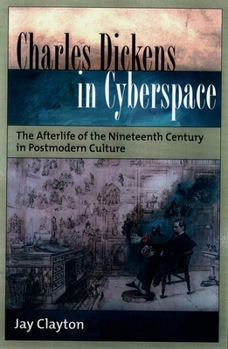< Back to Search Results
Charles Dickens in Cyberspace: The Afterlife of the Nineteenth Century in Postmodern Culture
Select Format
Select Condition 
Book Overview
Charles Dickens in Cyberspace opens a window on a startling set of literary and scientific links between contemporary American culture and the nineteenth-century heritage it often repudiates. Surveying a wide range of novelists, scientists, filmmakers, and theorists from the past two centuries, Jay Clayton traces the concealed circuits that connect the telegraph with the Internet, Charles Babbage's Difference Engine with the digital computer, Frankenstein's monster with cyborgs and clones, and Dickens' life and fiction with all manner of contemporary popular culture--from comic books and advertising to recent novels and films. In the process, Clayton argues for two important principles: that postmodernism has a hidden or repressed connection with the nineteenth-century and that revealing those connections can aid in the development of a historical cultural studies. In Charles Dickens in Cyberspace nineteenth-century figures--Jane Austen, Charles Darwin, Charles Dickens, Thomas Hardy, Henry James, Ada Lovelace, Joseph Paxton, Mary Shelley, and Mary Somerville--meet a lively group of counterparts from today: Andrea Barrett, Greg Bear, Peter Carey, H l ne Cixous, Alfonso Cuar n, William Gibson, Donna Haraway, David Lean, Richard Powers, Salman Rushdie, Ridley Scott, Susan Sontag, Neal Stephenson, Bruce Sterling, and Tom Stoppard. The juxtaposition of such a diverse cast of characters leads to a new way of understanding the "undisciplined culture" the two eras share, an understanding that can suggest ways to heal the gap that has long separated literature from science. Combining storytelling and scholarship, this engaging study demonstrates in its own practice the value of a self-reflective stance toward cultural history. Its personal voice, narrative strategies, multiple points of view, recursive loops, and irony emphasize the improvisational nature of the methods it employs. Yet its argument is serious and urgent: that the afterlife of the nineteenth century continues to shape the present in diverse and sometimes conflicting ways.
Format:Hardcover
Language:English
ISBN:0195160517
ISBN13:9780195160512
Release Date:July 2003
Publisher:Oxford University Press
Length:280 Pages
Weight:1.21 lbs.
Dimensions:1.0" x 6.3" x 9.7"
Customer Reviews
2 ratings
Postmodern Convergence of Science and Literature
Published by Thriftbooks.com User , 22 years ago
Who knew that Victorian science was populated with such unruly characters or that postmodernism could herald the convergence of the two cultures? Here is a critic who is unafraid to write with gusto about today's return to literature and who understands the ways of both novelists and hackers. I enjoyed the acount of Charles Babbage beside William Gibson and Bruce Sterling, Neal Stevenson with Charles Dickens.
Jay Clayton's Charles Dickens in Cyberspace
Published by Thriftbooks.com User , 22 years ago
This book shows such smarts and is such fun that I've been talking it up to every reader I know. Anyone interested in Cultural Studies or the nineteenth century novel will want this book (in fact, they might already have it, because the advance word on it has been good), but it will undoubtedly appeal to a larger audience, too. Jay Clayton demonstrates a familiarity with a wide array of further fields: communications technology, genetics, science fiction, film, and contemporary literature. Readers interested in any of these subjects will find that the historical parallels and hidden connections Clayton establishes between them are both unexpected and absorbing. What's more, Clayton can write. This is not a book choked by jargon or made ponderous by clumsy language. Here is a learned author who explains himself with gusto and grace. Clayton's book combines several propositions. First, that contemporary studies of American culture are essentially amnesiac and could only benefit from some historical perspective. Second, that the tendency towards emotional affirmation and homemade mysticism which characterizes our multicultural age is in many ways analogous to the Romantic era's reaction against the hyper-rationality of the Enlightenment. Third, that the enormous divide between the Humanities and the Sciences, which originally opened in the early years of the Victorian era, is now closing again as today's Information Technology blurs disciplinary distinctions and promotes cross-pollination between discreet endeavors. Clayton argues convincingly on all three points, and he weaves his several theses together to reveal how our postmodern complexities have antecedents in an earlier age. It is rare to find a thoroughly informed author who can anatomize an historical period in an accessible fashion. It's rarer still to find one with sufficient detachment to offer new analysis of his own times. Jay Clayton does both of these things, and he does them with an agreeable combination of persuasion and charm. A pleasure. An education. Highly recommended.





